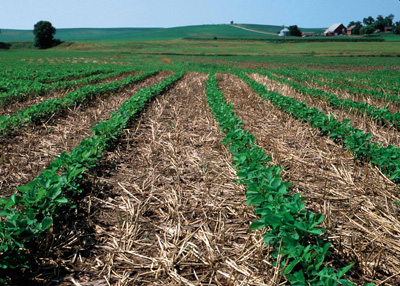|
|
 |
PAGE 66 / 102 |
 |
Unit 2: Applying Ecological Principles
Reduced- and No-Till
 |
No-till soybeans in Iowa growing in previous season’s crop residue. (Gene Alexander, USDA NRCS) |
Another key practice in sustainable agroecosystems is the use of various reduced tillage methods. As with other foundational practices, the underlying concept with reduced-tillage practices is the conservation and management of soil organic matter. The chief benefits of reduced tillage are:
-
reduced erosion,
-
improved soil quality,
-
cost savings from reduced labor and energy inputs, and
-
increased availability of water for crop production.
There are also potential problems associated with reduced tillage, and implementing these types of systems takes creativity and commitment on the part of the farmer. Some of the key challenges farmers face when making such changes are:
-
residue management – particularly related to planting of the subsequent cash crop. Specialized equipment has been developed for the purpose of planting through the surface residue into untilled soil.
-
cooler soil temperatures which can delay germination.
-
other changes in the soil environment (e.g., soil structure or soil moisture content) that may lead to disease problems.
-
weed control – without tillage as a weed management tool, growers may need to rely more on herbicides to kill weeds.
-
potentially lower nitrogen and phosphorus levels in the soil will require revised nutrient management practices.
|